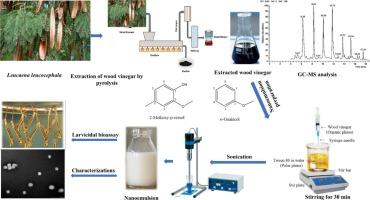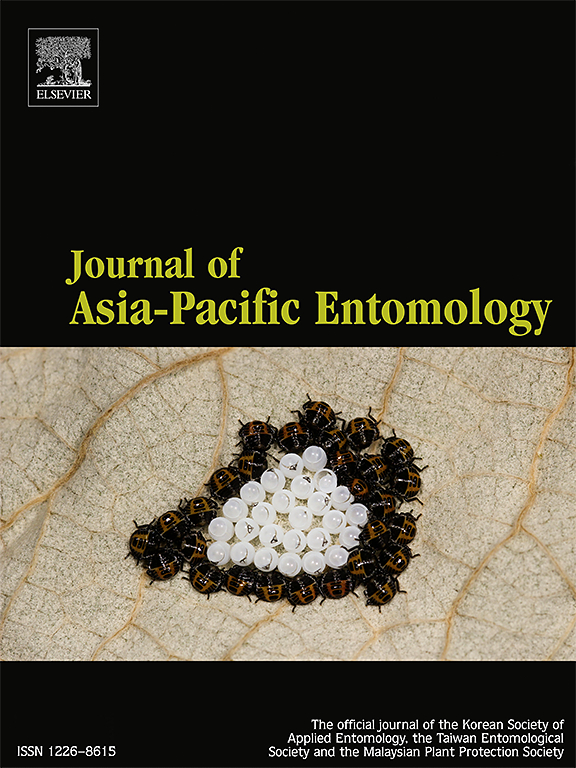Nanoemulsions of Leucaena leucocephala wood vinegar and main constituents exhibit high mosquitocidal activity against larvae of Culex pipiens L. (Diptera: Culicidae) via oxidative stress and neurotoxicity
IF 1.3
3区 农林科学
Q3 ENTOMOLOGY
引用次数: 0
Abstract
The present study investigates the mosquitocidal efficacy and biochemical effect of Leucaena leucocephala wood vinegar, its major chemical constituents (2-methoxy-p-creosol and o-guaiacol), and their nanoemulsion formulations against Culex pipiens larvae. The larvicidal bioassay revealed that the products exhibited time- and concentration-dependent toxicity against larvae, with nanoemulsion formulations significantly enhanced efficacy, especially for 2-methoxy-p-cresol, which achieved an exceptionally low LC50 of 0.09 mg/L after 48 h of exposure. Biochemical assays confirmed substantial alterations in larval enzyme activity, indicating oxidative stress and neurotoxic effects induced by the treatments. Gas chromatography–mass spectrometry (GC–MS) analysis identified key bioactive compounds, including 2-methoxy-p-creosol (18.48 % peak area) and o-guaiacol (17.32 % peak area), which were further evaluated through molecular docking against target enzymes acetylcholinesterase (AChE), adenosine triphosphatase (ATPase), glutathione S-transferase (GST), and carboxylesterase (CarE). Docking results demonstrated strong binding affinities, suggesting potential mechanisms of action. These findings highlight the potential of L. leucocephala wood vinegar and its nanoformulations as eco-friendly, plant-based mosquito control agents with promising bioactivity at both physiological and molecular levels.

白头翁木醋纳米乳剂及其主要成分通过氧化应激和神经毒性对淡纹库蚊幼虫表现出较高的杀蚊活性
研究了银合子木醋及其主要化学成分(2-甲氧基-对甲酚和邻愈创木酚)及其纳米乳制剂对淡库蚊幼虫的杀蚊效果和生化效果。生物测定结果表明,该产品对幼虫的毒性具有时间和浓度依赖性,纳米乳配方显著增强了对幼虫的毒性,特别是对2-甲氧基-对甲酚,在48 h后达到了极低的LC50,为0.09 mg/L。生化分析证实了幼虫酶活性的实质性变化,表明处理引起的氧化应激和神经毒性作用。气相色谱-质谱(GC-MS)分析鉴定出关键的生物活性化合物,包括2-甲氧基-对甲酚(18.48 %峰面积)和邻愈木酚(17.32 %峰面积),并通过与靶酶乙酰胆碱酯酶(AChE)、腺苷三磷酸酶(ATPase)、谷胱甘肽s -转移酶(GST)和羧酸酯酶(CarE)的分子对接进一步评价。对接结果显示出较强的结合亲和力,提示潜在的作用机制。这些发现突出了L. leucocephala木醋及其纳米制剂作为生态友好型植物基灭蚊剂的潜力,在生理和分子水平上都具有良好的生物活性。
本文章由计算机程序翻译,如有差异,请以英文原文为准。
求助全文
约1分钟内获得全文
求助全文
来源期刊

Journal of Asia-pacific Entomology
Agricultural and Biological Sciences-Insect Science
CiteScore
2.70
自引率
6.70%
发文量
152
审稿时长
69 days
期刊介绍:
The journal publishes original research papers, review articles and short communications in the basic and applied area concerning insects, mites or other arthropods and nematodes of economic importance in agriculture, forestry, industry, human and animal health, and natural resource and environment management, and is the official journal of the Korean Society of Applied Entomology and the Taiwan Entomological Society.
 求助内容:
求助内容: 应助结果提醒方式:
应助结果提醒方式:


